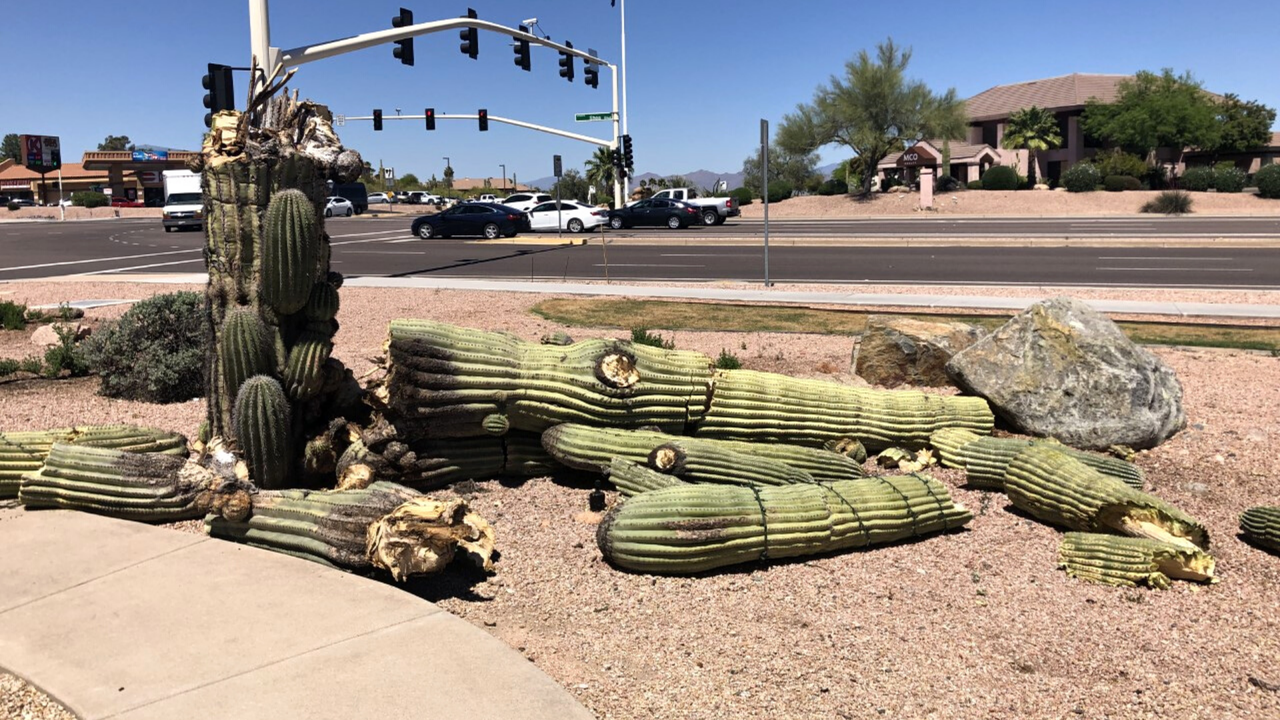Join the May EcoQuest: Saguaro Census.
Join the Saguaro Census
Interested in volunteering for a more active role in the Saguaro Census? View this training guide and join the Volunteer Saguaro Census project.
WHAT TO OBSERVE:
Find and map as many saguaros (Carnegia gigantea) in urban areas as possible!
We encourage you to go the extra mile and make notes about their size, number of arms, health and where they are located. Is it tall with three arms and looks full of water? Is it in a commercial area and looks brown? Let us know!
See this training video for help or use the handy Getting Started Guide.
Lookout! There’s a saguaro look-alike in the Valley: the cardon cactus (Pachycereus pringlei).
See photos for comparison here.
 This month’s EcoQuest is in collaboration with the Saguaro Census.
This month’s EcoQuest is in collaboration with the Saguaro Census.
During the summer of 2020, the metro Phoenix area recorded its hottest summer ever. There were numerous reports of saguaros losing arms or falling throughout the Valley. Why did this happen? Was this related to climate change? Are we eventually going to lose all our urban saguaros? These cactus are highly cherished in Arizona, and the possibility of losing them is a deep concern among many people. Several theories were discussed, mostly related to the increasing heat and lack of rain. The Desert Botanical Garden’s Research Department tried to answer as best as it could, however, there is not enough research to completely understand what is happening with these iconic plants and whether it is directly linked to climate change.

To look for answers, the Saguaro Census counts and documents saguaros in metro Phoenix. This is the first step to generate a database to monitor the saguaro population in the Valley, learn more about their health and research the effects climate change might have on them. This includes location information, notes and pictures of the plants in the city, so they can be can monitored them into the future. Working with Desert Botanical Garden, people can contribute to a real-life community science project.
The Saguaro Census is part of a larger project led by Dr. Hernandez, Desert Botanical Garden’s New World Succulents Specialist. The project seeks to understand the biology, distribution and genetics of the urban saguaro population by comparing them with their relatives growing in the wild. The project will also be used to develop tools to understand and preserve endangered cactus species in the Southwest with substantial community involvement.

"Urban areas are heat islands. Plants growing in cities are under serious heat stress — several degrees higher than in the wild. If saguaros in the city are dying now, do we expect this to happen to wild saguaros under future climate change? We can start planting saguaros brought from drier and hotter regions to better adapt our urban saguaro population to withstand future climatic conditions,” says Dr. Hernandez, “This is a great opportunity to study plant responses to heat and stress. Saguaro plants in the city are a climate change experiment, which would be impossible to generate artificially.”
The Saguaro Census is in collaboration with the Metro Phoenix EcoFlora and the Save Our Saguaros project, led by Girl Scout Gold Award recipient Ella Werre.
“People from the Phoenix area care so much about saguaros because they are part of our identity as Arizonans. I'm really excited to work on this project to make real change happen. I did my Girl Scout project in the hopes that the data I was collecting could be utilized by real scientists to help saguaros in the Phoenix area. Small steps, like using your smartphone to document saguaros in your area on iNaturalist, can lead to big changes in the quest for answers on saguaro health,” says Were.
Together, we can improve our understanding of saguaros and develop tools to adapt our urban plants to the hotter conditions we will face in the future.
Observing urban saguaros in metro Phoenix is the first step to generate a database to monitor the population in the Valley, learn more about their health and research the effects climate change might have on them. The data collected in this EcoQuest will contribute to future studies including sampling urban saguaros and learning more about their genetics.
WE NEED YOUR SAGUARO! If you have a saguaro growing on your property and are willing to allow DBG to study it, please email Dr. Hernandez at thernandez@dbg.org.
PRIVACY GUIDELINES
When making observations, please be mindful of private property and do not trespass..
Sources and more information:
The Saguaro Census
Why Desert Botanical Garden is Studying Urban Saguaros
Desert Botanical Garden Launches First-Ever Urban Saguaro Census
Save Our Saguaros Brochure
Save Our Saguaros Gold Award Project Website
About Dr. Tania Hernandez
Tania Hernandez is a Desert Botanical Garden research scientist specializing in succulent plants, particularly agave and cactus. The work in her lab is motivated by an interest to understand how and when these plants originated and how they evolved their adaptations to withstand water scarcity. Born and raised in central Mexico, Dr. Hernandez has been surrounded and astonished by cactus diversity all her life. What she finds more interesting is how these plants are modified from a common plan seen in most other plants, and then diversified into hundreds of species. The magnitude of these modifications has no equal in any other living lineage. Under her recent appointment at the Garden, Dr. Hernandez is working on developing genomics tools applied to better understand and preserve agave and cactus biodiversity.
About Save Our Saguaros: A Girl Scout Gold Award Project
Ella Were has been a Girl Scout for twelve years. As a culmination of the time and passion she has put into the program, she strove to complete her Gold Award, a service-based award that is the highest level of achievement in Girl Scouts. For her project, she was inspired by the death of a saguaro in her front yard, an event that surprised her, as it had seemingly been in good health. Working with Jeny Davis, EcoFlora Coordinator at Desert Botanical Garden as her project mentor, she put together a brochure and a website in hopes of helping the public understand more about this iconic symbol of Arizona. Using iNaturalist, she created a place where people can document saguaros in the urban Phoenix area to provide scientists with a more accurate look at population and general saguaro health in metro Phoenix.
About Desert Botanical Garden
An Arizona icon for more than 80 years, Desert Botanical Garden is a living museum of more than 50,000 plants. Founded in 1939, the Garden is a premier institution focused on education, exhibition, research and conservation of desert plants of the world, with an emphasis on the Sonoran Desert. A Phoenix Point of Pride, the Garden’s 140-acre site is distinguished by its robust collection of cactus and agave plants, as well as its scope and excellence of its programs in education, horticulture, plant research and conservation. Learn more at dbg.org.

EcoQuests are month-long challenges that are part of the larger Metro Phoenix EcoFlora project.
Learn more by visiting our website.
Look for project happenings, EcoQuest announcements and more in the newsletter, project journal and on social media.
Sign up for the newsletter, The Metro Phoenix Field Guide.
Let's be social on Instagram, Facebook, and Twitter.

Please do not observe indoor houseplants or pets.
For your own safety and the protection of plants and wildlife, do not trespass when making observations. Please follow all posted rules and guidelines in parks/preserves and do not enter private property.
Do not remove or move natural materials (plants, animals, rocks).
Respect wildlife (do not touch, feed, or disturb animals and keep a safe distance).
Observe COVID-19 Guidelines/Recommendations.
This is a great opportunity to observe and appreciate nature in our neighborhoods as we all navigate the complications of COVID-19. It is imperative that you follow COVID-19 guidelines/recommendations (wear a mask, practice physical distancing and wash your hands).
Do what’s best for you and your community.
For more COVID-19 information and guidelines, visit:
https://www.inaturalist.org/projects/city-nature-challenge-2020/journal/31768-cnc-covid-19
https://www.inaturalist.org/blog/31664-exploring-nature-when-you-re-stuck-at-home
Arizona Office of Tourism: Responsible Recreation in AZ
https://tourism.az.gov/responsible-recreation-across-arizona


















